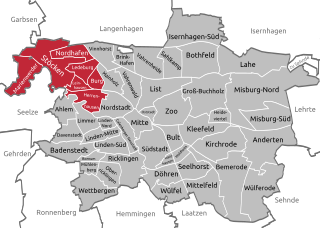
Herrenhausen-Stöcken is a borough of the German city of Hanover, northwest of the city centre. In 2020 it had a population of 37,543. It consists of the quarters Burg, Herrenhausen, Ledeburg, Leinhausen, Marienwerder and Stöcken.

Ernest Augustus, Duke of Brunswick-Lüneburg, was Prince of Calenberg from 1679 until his death, and father of George I of Great Britain. He was appointed as the ninth prince-elector of the Holy Roman Empire in 1692.

The Herrenhausen Gardens of Herrenhausen Palace are located in Herrenhausen, an urban district of Hanover, the capital of Lower Saxony, Germany. Dating to the era of the Kings of Hanover, they comprise Great Garden, Hill Garden, Georgen Garden and Guelf Garden.
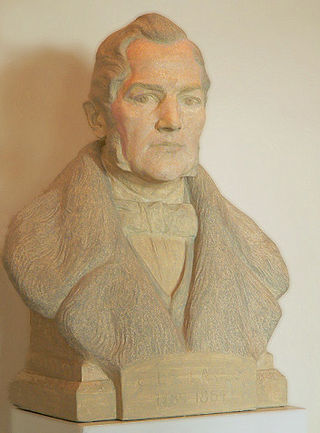
Georg Ludwig Friedrich Laves was a German architect, civil engineer and urban planner. Born in Uslar, Lower Saxony, he lived and worked primarily in the city of Hanover and also died there. He was appointed Oberhofbaudirektor, "court master builder", in 1852. As the leading architect of the Kingdom of Hanover for a career spanning 50 years, he had great influence on the urban development of this city. Alongside Karl Friedrich Schinkel in Berlin and Leo von Klenze in Munich, Laves was one of the most accomplished neoclassical style architects of Germany. As an engineer he developed a special iron truss lenticular or "fishbelly" beam bridge construction method, the so-called "Lavesbrücke". Laves found his final resting place in the Engesohde Cemetery in Hanover.

Marienburg Castle is a Gothic revival castle in Lower Saxony, Germany. It is located 15 kilometres (9.3 mi) north-west of Hildesheim, and around 30 kilometres (19 mi) south of Hannover, in the municipality of Pattensen, Hannover. It was also a summer residence of the House of Welf whose flag flies on the main tower. The castle was a filming location in the Amazon Prime Video series "Maxton Hall" (2024).

Calenberg Castle was a medieval lowland castle in central Germany, near Schulenburg in the borough of Pattensen, 13 km west of the city of Hildesheim. It was built as a water castle in 1292 by the Welf duke, Otto the Strict, in der Leine river meadows between 2 branches of the Leine river on the southern part of the chalk marl hill of the Calenberg. At the start of the 16th century it was converted into a fort (Feste). In the 15th century, Fort Calenberg gave its name to the Welf Principality of Calenberg. Following the Thirty Years' War it lost its military importance and was slighted. Today it is a ruin with underground vaults that are surrounded by high ramparts.
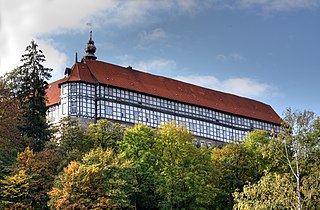
Herzberg Castle is a German schloss in Herzberg am Harz in the district of Göttingen in the state of Lower Saxony. The present-day, quadrangular building has its origins in the 11th century as a medieval castle. After a fire in 1510 it was rebuilt as a schloss and is one of the few in Lower Saxony that was constructed as a timber-framed building. Because it belonged to the House of Welf for 700 years it is also known as the Welf Castle of Herzberg.

Hanover University of Music, Drama and Media is a university of performing arts and media in Hanover, the capital of Lower Saxony, Germany. Dating to 1897, it has reorganised and changed names as it developed over the years, most recently in 2010 when it changed from State College of Music and Drama Hanover. Since 2010, its president has been Susanne Rode-Breymann. As of 2021, the university has 1,484 students and a total of 477 staff.

Girolamo Sartonio, also known as Hieronimo Sartorio and Geronimo Sartorio, was an innovative Italian architect and engineer who worked mainly the German cities of Hanover, Hamburg, Leipzig and Erfurt. His designs were based on Palladian architecture. He was a noted expert in the installation of stage equipment and theatrical machinery and also worked as a builder or consulting architect on the construction of various opera houses, such as the Oper am Gänsemarkt in Hamburg. He is also credited with the beginnings of opera in Leipzig and the construction of the opera house in Prague.

The Garden Cemetery is a cemetery in Hanover, Germany. It was created in 1741 and is located by the Garden Church built in 1749. The cemetery and the church are both named after the garden parish outside the former parish city walls in front of Aegidien Gate. The cemetery, which contains a number of classicising grave markers from the first half of the nineteenth century, was closed in 1864 with the establishment of the Stadtfriedhof Engesohde. Today it forms a park in the middle of inner city Hanover. The graves of Charlotte Buff, the astronomer Caroline Herschel and the painter Johann Heinrich Ramberg are located here. The Gartenfriedhof lies on Marienstraße between Warmbüchenstraße and Arnswaldtstraße.

Georg Peter Hermann Eggert was a German architect. He designed important public buildings such as the Frankfurt Main Station and the New Town Hall in Hannover, often in the style of Neo-Renaissance.
The following is a timeline of the history of the city of Hanover, Germany.

The Church of the Holy Cross is a Lutheran church in the centre of Hanover, the capital of Lower Saxony, Germany. A Gothic hall church, it is one of three churches in Hanover's old town – the other two being Market Church and Aegidien Church, although the latter is now a war memorial.

The Old Town Hall is a former, and the first, town hall in Hanover, Germany. Originally built in the old city district in 1410, replaced by the New Town Hall in 1913, and extensively restored in 1953 and 1964 after heavy bomb damage in World War II, it is the oldest secular building in the city. The market façade with the highly sophisticated Brick Gothic of the lucarnes has been preserved and partly restored in its medieval shape. Some elements of it were copied on other wings of the building.
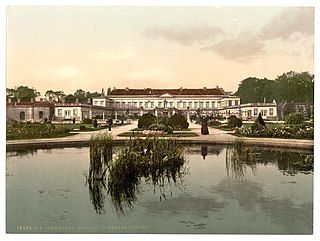
Herrenhausen Palace is a former royal summer residence of the House of Hanover in the Herrenhausen district of the German city of Hanover. It is the centerpiece of Herrenhausen Gardens.

Hanover Historical Museum is an historical museum situated in Hanover, the capital of Lower Saxony, Germany. The museum was founded in 1903 as the Homeland Museum of the City of Hanover. Its collections are related to the history of the city, the history of the House of Guelf, and of the state of Lower Saxony.
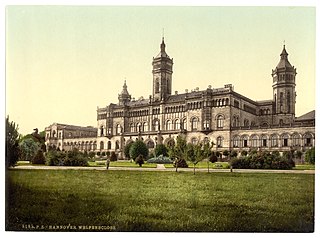
Christian Heinrich Tramm was a German architect who, in 1850, introduced the Rundbogenstil in Hanover.

The Welfenschloss Stables is the residence of the Technical Information Library at the Leibniz University Hannover. It was built in 1863–1867 during the reign of the last Hanoverian king, George V as the royal stables for the Welfenschloss palace.
Carl Christoph Conrad Rangenier was a German sculptor, best remembered for his sculpture of George I of Great Britain at Guelph Castle in 1862, and the altar crucifix for the Evangelical Lutheran parish church in Graste in 1864 under Conrad Wilhelm Hase.
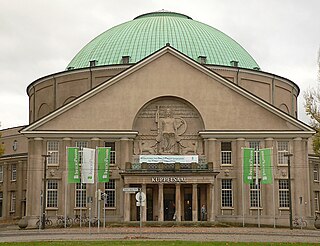
The Stadthalle Hannover is a concert hall and event venue in Hanover, the capital of Lower Saxony, Germany. The large hall is called Kuppelsaal, after its dome. The hall was opened in 1914. It is the largest hall for classical music in Germany, seating 3,600. Severely damaged during World War II, it was restored slightly altered. The hall is now part of the Hannover Congress Centrum. The listed historic building is a landmark of the city.


























